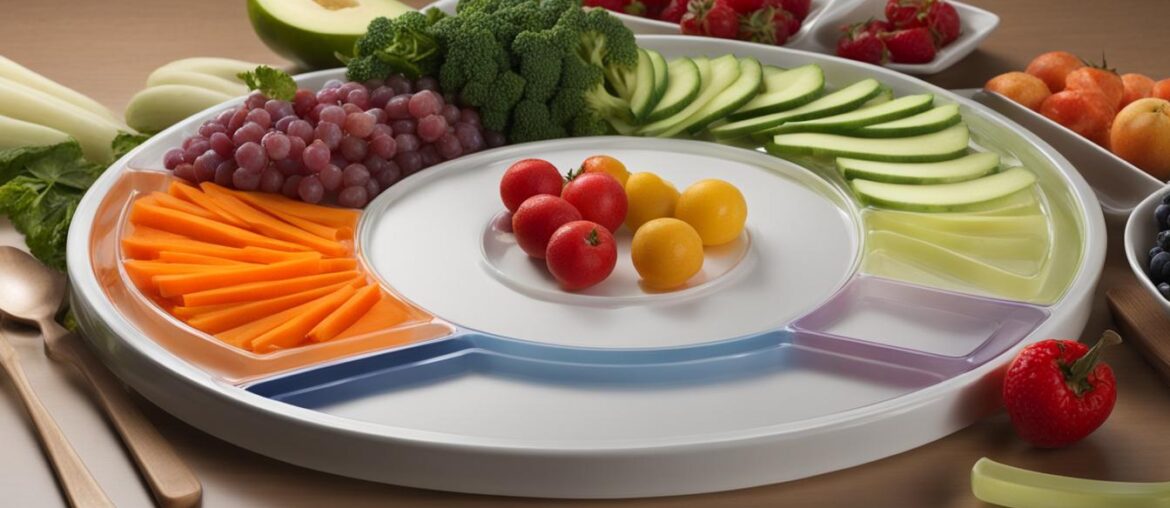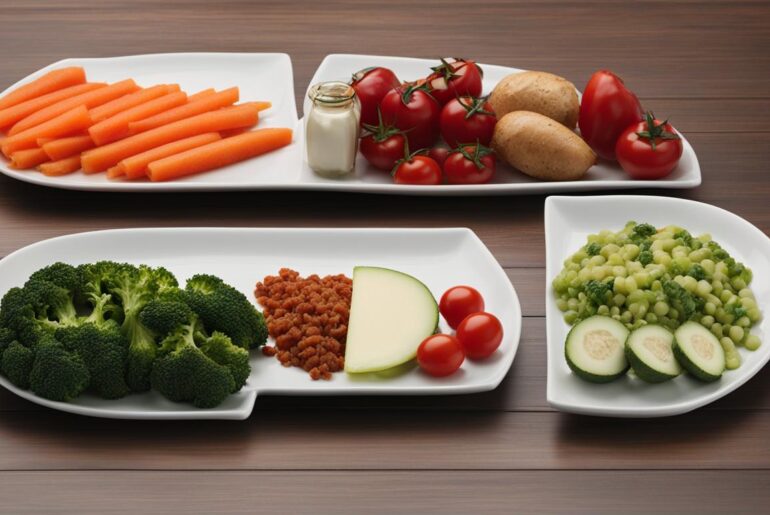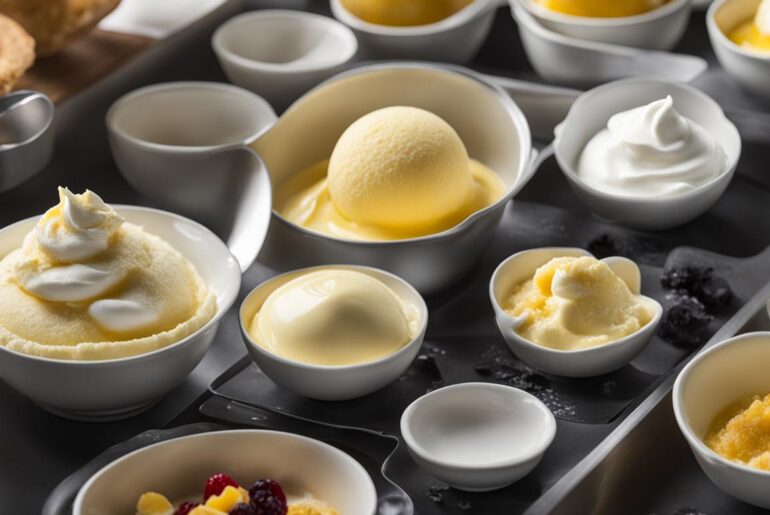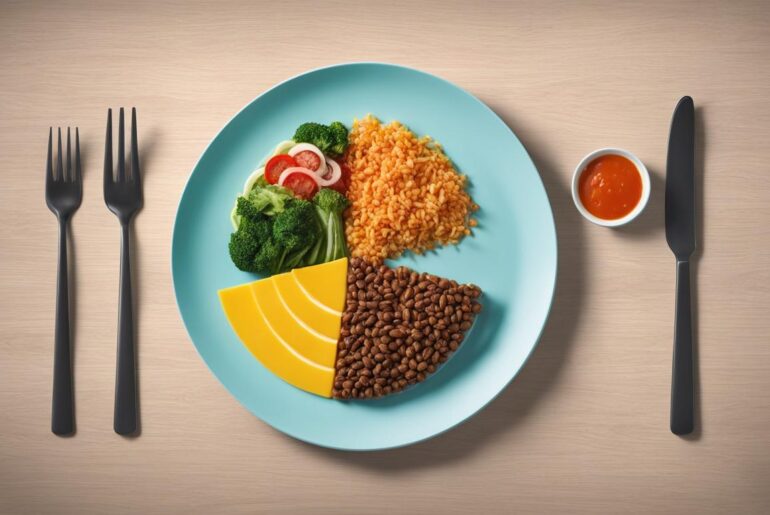When it comes to maintaining a healthy weight and managing portion sizes, visual guides can be an invaluable tool (check out my post on managing portion sizes here). Studies have shown that providing individuals with larger portions can lead to overeating and weight gain. To counteract this, incorporating visual guides for portion controlling can help individuals make better choices and improve their overall health.
Visual guides for portion controlling provide a clear and tangible reference for serving sizes, making it easier to determine appropriate portions for different food groups. By visually representing the recommended portion sizes, these guides act as a visual aid that helps individuals better understand how much they should be eating.
Key Takeaways:
- Visual guides for portion controlling are useful tools for managing portion sizes and promoting healthy eating habits.
- Studies have shown that larger portion sizes can contribute to weight gain, while controlling portions can lead to better weight management.
- By using visual guides, individuals can better gauge appropriate portion sizes for different food groups, such as proteins, vegetables, carbohydrates, and fats.
- Visual guides act as a visual aid and provide a clear reference for serving sizes, helping individuals make more informed choices.
- Incorporating visual guides for portion controlling can be an effective strategy for optimizing meals and promoting a balanced diet.
Portion Control Strategies and Tips
https://www.youtube.com/watch?v=WjD6iD2lClg
When it comes to maintaining a healthy diet, portion control is key. By being mindful of how much we eat, we can better manage our calorie intake and promote overall well-being. Here are some effective strategies and tips to help you with portion control:
1. Use Smaller Plates and Bowls
Believe it or not, the size of your dinnerware can influence how much you eat. When you use smaller plates and bowls, your brain perceives the portion as larger, leading to a sense of satisfaction with less food. So, try downsizing your dishes to trick your mind into eating smaller portions.
2. Drink Water Before Meals
Drinking a glass of water before your meals can help curb your appetite and control portions. Water creates a feeling of fullness, reducing the amount of food you eat during your meal. Plus, staying hydrated is essential for overall health and well-being.
3. Eat Slowly and Mindfully
It takes time for the body to register feelings of fullness. By eating slowly and mindfully, you give your brain the chance to catch up with your stomach. This can prevent overeating and help you realize when you've had enough to eat. So, savor each bite, chew thoroughly, and pay attention to the taste and texture of your food.
4. Keep a Food Journal
Keeping a food journal can increase your awareness of portion sizes and help you manage your food intake. By writing down what you eat and drink, you can identify any patterns of overeating or areas where portion control can be improved. It's a helpful tool for self-reflection and making positive changes in your eating habits.
5. Utilize Visual Guides
Visual guides can be powerful tools in practicing portion control. They provide a clear understanding of what a healthy portion looks like, making it easier to adjust your meals accordingly. One popular visual guide is the Nerd Fitness Healthy Plate, which divides your plate into sections for protein, vegetables, carbohydrates, and fats. This visual cue helps you create balanced meals and control your portion sizes effectively.
Remember, everyone's portion control needs may vary based on factors like age, sex, activity level, and specific dietary requirements. It's important to consult with a healthcare professional or registered dietitian to determine the best portion control methods for you (see my post here).
Having a variety of portion control strategies in your arsenal can help you maintain a balanced and healthy diet (see my post here). Experiment with different techniques to find what works best for you. Practice mindful eating, pay attention to your body's cues, and embrace the power of visual guides like the Nerd Fitness Healthy Plate. By taking control of your portion sizes, you can optimize your meals and support your overall well-being.
The Role of Protein and Vegetables in Portion Control
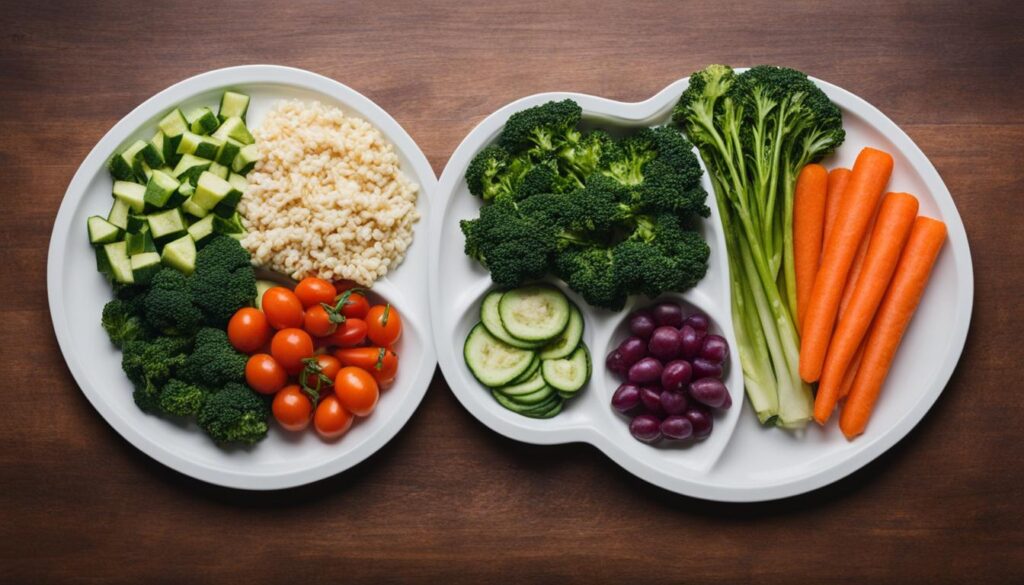
Protein and vegetables are essential components of portion control. Understanding the appropriate portion sizes for protein and vegetables is key to maintaining a balanced diet. A proper serving of protein should be about the size and thickness of your palm, while a serving of vegetables should be about the size of your fist.
Including adequate amounts of protein and vegetables in each meal not only provides essential nutrients but also helps with portion control. These nutrient-dense foods contribute to a sense of fullness and satisfaction, reducing the likelihood of overeating. By prioritizing protein and vegetables, you can ensure that they occupy a significant portion of your plate.
Visual aids, such as the Nerd Fitness Healthy Plate, can be useful tools in implementing portion control. This plate illustrates the ideal proportions of protein, vegetables, carbohydrates, and fats, making it easier to select appropriate portion sizes and create a well-balanced meal.
“Including a good serving of protein and vegetables in each meal can help with portion control by providing a sense of fullness and satisfaction.”
Managing Carbohydrate and Fat Portions
When it comes to maintaining a healthy diet, portion control is crucial, especially when it comes to carbohydrates and fats. Overconsumption of these macronutrients can lead to weight gain and other health issues. To ensure you're consuming the right amount of carbohydrates and fats, it's essential to understand portion sizes.
A serving of carbohydrates is about two cupped hands, while a serving of fat is roughly the size of the thumb.
By visualizing these portion sizes, you can accurately measure and control your carbohydrate and fat intake. Incorporating healthy carbohydrates, such as whole grains, legumes, and starchy vegetables, provides essential nutrients while keeping portions in check. These options are rich in fiber, vitamins, and minerals, making them excellent choices for a balanced diet.
Similarly, including healthy fats, such as avocados and nuts, in moderation is crucial for overall well-being. Healthy fats are essential for proper brain function, hormone production, and nutrient absorption. By controlling fat portion sizes, you can enjoy the benefits of these fats without exceeding your calorie intake.
When planning your meals, aim for a balance of protein, vegetables, carbohydrates, and fats. This promotes balanced nutrition and portion control, ensuring you get the necessary nutrients while maintaining a healthy weight. Remember, portion control is not about restriction but about making informed choices and finding the right balance in your diet.
Conclusion
Visual guides for portion controlling can play a vital role in optimizing meals and promoting healthy eating. By utilizing strategies like portion-control plates and implementing portion control tips, individuals can effectively manage their portion sizes and maintain a balanced nutrition (see my post here). Incorporating adequate portions of protein, vegetables, carbohydrates, and fats can further support portion control efforts, aiding in weight management and overall health improvement.
With the right knowledge and tools, individuals can take control of their portion sizes and make informed choices for a healthier lifestyle. Visual guides provide a practical and visual approach to portion control, making it easier to understand and implement in daily meals. By following portion control strategies and using tools like portion-control plates, individuals can optimize their meals, ensure they are consuming appropriate portion sizes, and contribute to their overall well-being.
Remember, portion controlling is an essential aspect of healthy eating. By being mindful of portion sizes and incorporating visual guides, individuals can better manage their portions, prevent overeating, and maintain a balanced diet. Prioritizing portion control and making conscious choices about the quantity and quality of food will not only support weight management but also contribute to long-term health and well-being.

